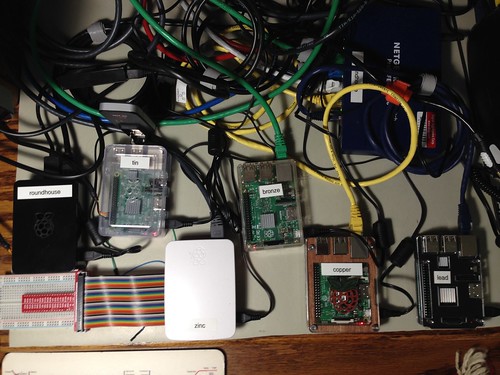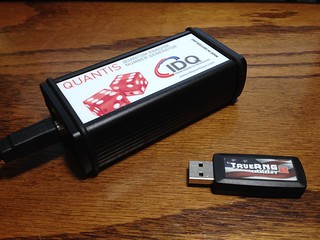Bah! I've been hearing the IP address doomsdayers complain for years but people are still hooking up their thermostats to the Internet. IPv6 is a lie. I'll only believe it exists when I see polar bear that can support a 128bit address.and
Please supply the names of all staff involved in engineering IPv6 readiness.and even
I for one do not believe that IPv6 is caused by humans.See what I mean? In any case, I decided it was time for me to see what IPv6 had to offer.
(The following was updated on 2017-01-19.)

Roundhouse is my IPv6 router than runs the open source OpenWrt on a Raspberry Pi 2, and manages an IPv6-through-IPv4 WAN tunnel via Hurricane Electric, an (among other things) IPv6 tunnel provider. The router exposes the IPv6 WAN over an Ethernet switch on the upper right.
You can find the Roundhouse project, which is mostly just a makefile and some configuration, here:
http://github.com/coverclock/com-diag-roundhouse
The other Raspberry Pi 2 and 3 systems shown here, scrounged from other projects, form the bulk of my IPv6 testbed.
Tin has as its only network connection an LTE cellular modem through which it uses IPv6. I use it for penetration testing of my IPv6 firewall and to demonstrate the global routing of IPv6 global unicast addresses.
Zinc is normally used for testing software that handles GPIO and serial ports, but here it accesses systems on the IPv6 testbed from my production IPv4 network.
Bronze is normally my 32-bit ARM reference platform, but here it demonstrates a dual stack capability by using IPv4 on the IPv6 LAN.
Copper accesses IPv6 devices using a variety of mechanisms including IPv6 global unicast addresses, v4-mapped IPv6 addresses, and IPv6 local unique addresses.
Lead acts as a server, accepting datagrams over UDP or connections over TCP, and echoing any data it receives back to the sender.
I've been expanding Diminuto, my open source C/Linux/GNU-based systems programming library, to support its socket API on IPv6. It wasn't difficult. This library includes the software I've been running on on the Raspberry Pis. Portions of Diminuto have found their way into several commercial products. You can find it here:
http://github.com/coverclock/com-diag-diminuto
Finally I'm still collecting and testing hardware entropy generators, a project called Scattergun that my alter ego recently gave a talk about. I hope to one day write more about that.

You can find Scattergun here:
http://github.com/coverclock/com-diag-scattergun
I hope this convinces you that I have not been slacking off during the holidays.
Best wishes to you and yours. Season's greetings!
(And an especially jolly Ho Ho Ho and Thank You to Alan, Doug, and Dale for their IPv6 comments.)

No comments:
Post a Comment